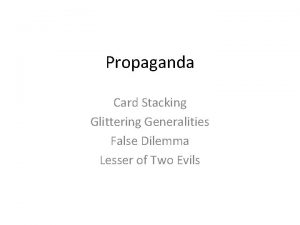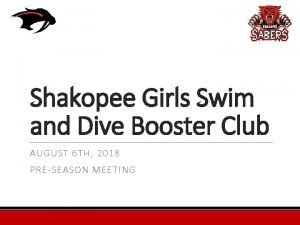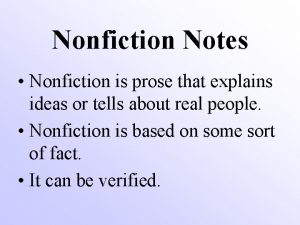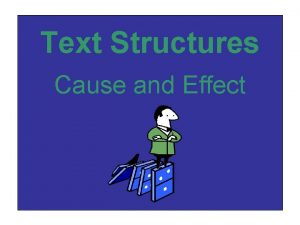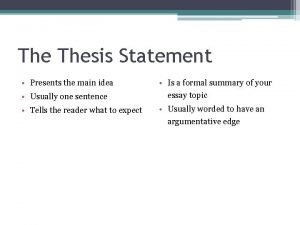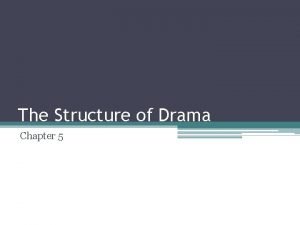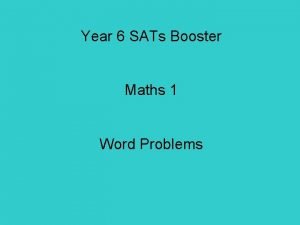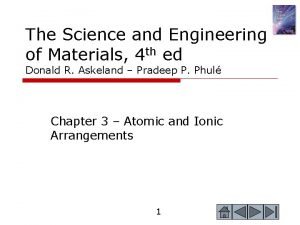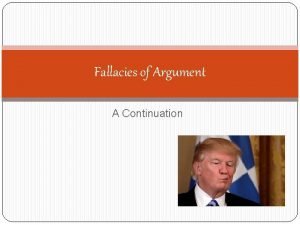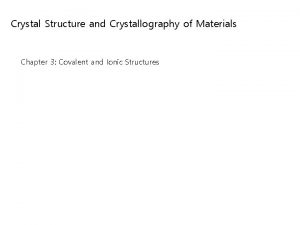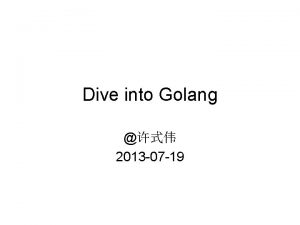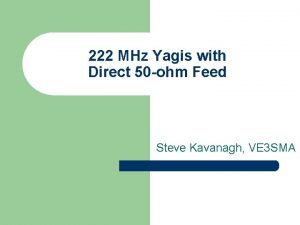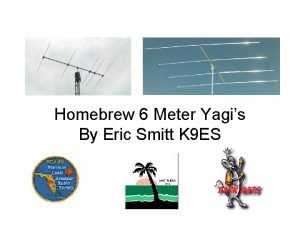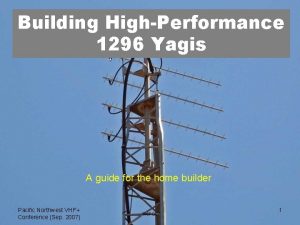CTU Presents A Deep Dive Into Stacking Yagis











































































- Slides: 75

CTU Presents A Deep Dive Into Stacking Yagis by Greg Ordy, W 8 WWV

Let’s Get Started! l l This is a big topic, too long for one CTU session. l Could be a chapter in a book, or an entire book. l Let’s limit it for this forum and 45 minutes. l Slides have been tweaked since published in the CTU book. We are going to be talking about HF Yagis in the 40 meter to 10 meter frequency range with horizontal polarization and stacked vertically. VHF/UHF Yagis change the playing field a little because of their very long boom lengths and extreme heights above ground – relative to wavelength. Propagation modes are also different. We need to (quickly) get through some background material first so that we are all on the same page…

Stacking Introduction l l l When I was a young ham, almost 50 years ago, I heard this nugget of wisdom about antennas: Get as much metal as you can as high in the air as you can. There is a lot of truth to that statement. When I first heard about the idea of stacking Yagis, I thought: I get it, more antennas equals more metal equals more gain! Although adding antennas should add gain, it is probably most important to make sure that we do not end up with deep nulls in the elevation pattern that negate all of our hard work in building the stack. l No matter how much maximum gain you have at some take off angle, a 20+ d. B null wipes it all away at another take off angle. l Avoiding vertical nulls is the constant theme of this presentation. l Beware the Lurking Null!

Stacking Introduction (2) l Evaluating the design of a stack should always include a consideration of the elevation nulls and making sure that they don’t swallow up energy from desirable take off angles. l l This evaluation leads to a related question: l l This is the open manhole cover we want to avoid. We should not fixate on gain and miss the nulls. Can my Yagi antenna ever be too high? The answer is yes! Height above ground is the primary factor in determining the elevation pattern. l This is one violation of what I heard as a young ham.

Stacking Introduction (3) l l Other factors beyond nulls matter too. Like gain! While we should all know that a low SWR is not proof of overall antenna performance, it is a factor to be considered. l l l A dummy load has a low and flat SWR but is a poor antenna. SWR is not everything, but it is something. Especially in contesting, often with guest operators, having a low and flat SWR reduces the need for endless amp tweaking in the heat of battle. This takes us into the different methods for feeding a stack to create a low SWR.

Single Yagi over Ground l l l Although a single Yagi is not a stack, we can learn a lot by taking a look at its performance as a function of height above ground. From Yagi Antenna Design by Jim Lawson, W 2 PV (SK) (page 57): l Thus, we see that the main lobe of an antenna occurs at an angle primarily determined by its height above ground, but secondarily by the natural antenna directivity. Maximum gain occurs in the main pattern lobe, and nulls occur above and below the main lobe, in fact, they define the main lobe! (you can’t escape nulls) The maximum forward gain of a Yagi occurs at a particular take off angle that is never too far from a null take off angle. They get closer together as the height increases. A single Yagi has properties like a stack because it is interacting with its image antenna created by the effect of real ground.

Single Yagi over Ground (2) l Let’s verify the Lawson lobe/height claim with some antenna models. l l l ARRL Antenna Book(23 rd edition) model ARRL_315 -12. EZ. 3 elements on 15 meters on a 12’ boom @ 21. 1 MHz. EZNEC Pro/4, version 6, real/average ground. . . Step through the elevation patterns as a function of height, in ¼ wavelength steps starting at ¼ wavelength. l ¼ wavelength at 21. 1 MHz is 11. 66’, rounded up to 12’ because that’s nice and easy to multiply. ¼ to 4 wavelengths is 12’ to 192’ in 12’ increments (with a few feet of rounding error at the top end).

Single Yagi over Ground (3) l In case my fancy animation is not available: The concern is falling into a null, especially as the height increases.

Single Yagi over Ground (4) #Peaks = 2 H Odd ¼ heights have overhead peaks. See May/June 2017 QEX, page 28, Kai Siwak, KE 4 PT. ¼ to 4 wavelength height off ground, ¼ wavelength steps.

Single Yagi over Ground (5) l Graph of maximum gain, main lobe angle, and first null angle above the main lobe as a function of height. Max. forward gain tops out around one wavelength, but the main lobe continues to tip down, as does the null. The null angle grows closer to the max. forward gain angle. The higher a Yagi, the more it needs to be part of a stack. Extreme height is about getting access to extremely low angles.

Single Yagi over Ground (6) l l l These results are for a 3 element Yagi. Increasing the boom length will make it more directive in the vertical plane, narrowing the main lobe even further. Stacks of Yagis have similar nulls, although depending upon heights and the feed system you can get a wide range of results. l l You can’t have a high gain lobe without nulls on the sides whether it’s due to 1 Yagi, or 2, or 10! But, a null(s) is usually in there somewhere, and we want to be aware of it and make sure it is filled in by using some particular configuration of the stack. Keep track of the maximum gain angles as well as the minimum gain (null) angles. Operating in a null is a buzz kill. The higher the maximum gain, the narrower the main lobe, and the closer the nulls are around the main lobe.

A Single Yagi is like a Stack… l l The way to analyze the effect of ground on an antenna is to create an image an equal distance under ground, and out of phase. A stack of one Yagi is similar to two with a spacing of 2 h (d) and BOP phasing. One positive side effect is gain due to the reflection off of ground, focusing energy at some take off angles. And nulls! l l Always a null at 0 degrees. The ground giveth, the ground taketh away. Elevation pattern, Free Space NOTE: same 3 L 15 m Yagi, gain is 7. 47 d. Bi down from 13 d. Bi (about 6 d. B difference).

A Single Yagi is like a Stack (2) l l l Antenna Physics: An Introduction. From the ARRL. Robert Zavrel, Jr. W 7 SX EMPro is a Keysight product.

Elevation Angles of Interest l l It’s pretty clear that we need to understand the elevation angles of the signals we care about to see if they fall in a null. I know of two ways to generate that information. l The old fashioned way is to consult tables in the ARRL Antenna Book (and probably other sources). l l The newer way is to use the HFTA (HF Terrain Assessment) program. It takes into account the actual site topography and combines it with antenna pattern information computed from a simple description of the stack. l l l This data is in the Antenna Book up to and including the 18 th edition (1997). This approach is in the 19 th and later editions of the ARRL Antenna Book. Elevation angles are a function of many factors, including the band, point in the sunspot cycle, radio locations on the planet, number of skips, and height of the layers that cause skipping (e. g. E, F 1, F 2…). At different times, the same path may occur at different angles. That’s part of the fun! When you think about it, without the fun of propagation, HF operation would be way too predictable.

Elevation Angles of Interest (2) l From the 18 th edition Antenna Book (1997). l l Based upon IONCAP runs. The first two peaks are shown. Nulls falling over a peak are a problem! This is a very broad overview of the angles, but, it helps suggest a range.

Elevation Angles of Interest (3) l Later Antenna Book editions began including similar information in a different format. l l l More detail, but less high level view. We can see two peaks here, around 4 -6 degrees and 10 -12 degrees. Note that the angle range tends to cluster lower as you go up in frequency.

Elevation Angles of Interest (4) l l l HFTA – HF Terrain Assessment, Dean Straw, N 6 BV. l Windows PC program. Part of the recent edition Antenna Books (on the CD at the back of the book). This program not only features more geographic locations, but includes elevation pattern information computed for a general stack description that is not as complex as a full blown NEC/EZNEC model (face it, coming up with a model is work). This makes it great for what-if analysis and project planning. HFTA handles a stack of 1 to 4 identical Yagis with 1 to 8 elements can be evaluated with both in and out of phase combining.

Elevation Angles of Interest (5) l Let’s look at a generic 3 element 15 meter Yagi at 96’ (2 wavelengths). This was an earlier example as a model.

Elevation Angles of Interest (6) l l But wait, this should be the same result as we saw with the antenna model, since the terrain profile is FLAT, as in an antenna model. A perfect world.

Elevation Angles of Interest (7) l Indeed we can compare the two and they are quite close. Two ways of saying the same thing.

Elevation Angles of Interest (8) l l But wait, there’s more! We can add in elevation data representing two points on the globe. Let’s pick W 8 -Ohio for one end, and Europe for the other. This is similar to what was once in the tables on paper. There are over 1000. PRN files on the 23 rd edition!

Elevation Angles of Interest (9) l l l On one graph we can see what we have versus what we need. Our main lobe is over a lower occurrence range, and we have a null where a few percent of the signals occur. Keep high probability signals out of the nulls!

Elevation Angles of Interest (10) l l l But wait, there is even more! We can bring in the actual terrain data for the location of our antenna tower. Local terrain can have a substantial impact on the actual pattern of the real antenna. l This explains why similar installations in the same general area can have very different performance. It’s the location, stupid. Antenna models assume a flat and perfect region around the antenna. Generating the local terrain data can be a time consuming tedious process. But, k 6 tu. net has an online calculator that automatically generates data files for all 360 degrees of azimuth around a given longitude/latitude. See the site for information.

Elevation Angles of Interest (11) l l l I generated terrain data for my location. For the 45 and 270 degree directions, here is the result. The sharp drop to the west is the Chagrin River Valley. So what impact does the terrain have on my Yagi at 60’? ? ?

Elevation Angles of Interest (12) l l l Green is the response in a flat world, similar to the NEC model. Red is towards EU (45) which suffers a little from the hill. Blue is towards the west (270), that enjoys a boost, especially at very low angles.

Elevation Angles of Interest (13) l l l l Back in the day (~1960), Frank Lewis, W 3 CRA (SK), was known to have one of the consistently louder signals on 20 meters into Asia. He used a modest 3 element Yagi on a 70’ tower! The magic turned out to be his location on the side of a hill over a valley sloping towards Asia. HFTA analysis shows 12 to 15 d. B of added gain over a flat site. (!!!) His location (blue) was better than being located at the top of the hill (green). Red is the performance of a flat site. Material from the Bill Tippett, W 4 ZV, web site.

Elevation Angles of Interest (14) l l Antenna models and HFTA are powerful tools for evaluating the performance of a stack. HFTA allows you to configure stack models in a matter of seconds with elevation patterns as good as a detailed antenna model. l It’s possible to include the impact of the terrain around the tower site. Models (NEC, EZNEC, 4 nec 2) are more detailed and tedious to construct, but details like the feed system can be included that provide insight into characteristics such as SWR and bandwidth. l Models can evaluate factors such as the element tapering schedule – an essential part of the construction process. Whenever I’m involved in a stack project, I use both tools to make sure that important take off angles are not dropped into a null (and track the max gain and F/B and SWR…. ).

Single Yagi over Ground l l l l Let’s revisit the single Yagi once more before moving on. It’s a stack of one. For a classic tribander on a tower, is there such a thing as the best height? This is one of those religious topics that is clearly a compromise situation. Very generally speaking if you take all of the data on take off angles together, you find that it tends to fit in the range of 3 to 17 degrees (Lawson, page 5 -12). Covering this range translates into a height of 1. 5 wavelengths. But, 1. 5 wavelengths on 20 meters is 3 wavelengths on 10 meters. It’s very hard to have your cake and eat it too with a single multiband Yagi at a fixed height!

Single Yagi over Ground (2) l It has been suggested that a good overall compromise height for 20 through 10 meters is 60 to 80 feet. (~1 WL on 20, ~2 WL on 10) l l l This suggestion is based upon avoiding nulls, not maximizing gain. It also weighs domestic and DX contacts equally. Raising the antenna higher will certainly improve lower angle performance. But, some signals will then fall victim to a higher angle null. Did you expect a free lunch? Yes, your Yagi can be too high.

Stack Spacing l l l What’s a stack? I’m calling it two or more Yagis on the same tower having at least one operating mode where they are combined together and work collectively. It’s also possible to have multiple (same band) Yagis on one tower that are independent of each other and picked for their individual characteristics. l Large differences in height where the combination is not a useful pattern. l Different azimuth directions. One is fixed on the Caribbean, for example. l In this case, they are combined in an antenna switch, not a box that additionally performs impedance matching and/or phase inversion.

Stack Spacing (2) l l Consider a tower with a 5 L 10 meter Yagi at 30’ and one at 200’. Over flat ground, HFTA predicts: Where does the blue trace (combined in phase) win? Not very often! There is value in each antenna, but not much in their combination.

Stack Spacing (3) l l l Stacks help us avoid nulls at important take off angles by providing a set of selectable Yagi combinations. Each will have nulls. But between the set of combinations we want to have a choice for every angle in the range we care about. Every null is filled in with a lobe from another combination. The stack does not eliminate nulls, they are a necessary part of a focused main lobe which provides gain. It’s not uncommon to be quickly switching between stacking alternatives, looking for the take off angle that is best for the target signal. It’s not uncommon to prefer lower angle choices at the beginning and end of an opening, and higher angle choices during the opening.

Stack Spacing (4) l In choosing the distance between Yagis, there are two important considerations (beyond available space on the tower!). l The impact on the gain and pattern. l The impact on the feed point impedance. l All of the practical feed systems I am aware of make the assumption that each Yagi has a minimal interaction with its neighbors (near zero coupling) and can be treated as a 50 Ohm load. So, for example, two 50 Ohm Yagis can be combined in parallel, creating a 25 Ohm junction impedance that can then be transformed back to 50 Ohms for the radio. § l l Because of the assumption of 50 Ohm Yagi impedance, the OWA design is very attractive since that’s its strong point (monobanders of course). If there is significant coupling between antennas the feed point impedances will shift because of the nearby antennas. Solving coupling problems is not impossible, just much harder.

Stack Spacing (5) l Typical HF Yagi spacing is 0. 5 to 1 wavelength. l l In theory, adding a second identical Yagi should increase the gain by 3 d. B. l l The ARRL Antenna Book highlights 0. 6 to 0. 75 wavelengths. Larger spacing reduces coupling between Yagis. There is a rule of thumb associated with VHF/UHF Yagis which is to space them 2/3 of the boom length. Practically, the gain increase is less. Moving from a stack of 2 Yagis to 4 adds an additional ~3 d. B (~6 d. B total over 1 Yagi).

Stack Spacing (6) l l l l Let’s investigate stack spacing with a model of two, 10 meter 6 L OWA Yagis on 26’ booms. The lower one will be fixed at 1 WL (35’). The upper one will move up in steps of 0. 1 WL (3. 5’) from 1. 5 WL to 2. 2 WL (77’). This is a net spacing difference of 0. 5 WL to 1. 2 WL. They will be fed with equal currents. l This is a useful and common assumption, but it can be challenged when there are more than two Yagis in the stack. We want to follow the pattern and the feed point impedances. Baseline: Single Yagi: at 35’ : 15. 06 d. Bi @ 13°, at 77’: 15. 56 d. Bi @ 6°.

Stack Spacing (7) l 0. 5 to 1. 2 WL spacing in steps of 0. 1 WL by moving up the top Yagi.

Stack Spacing (8) l In case my fancy animation is not available: Greater spacing tips lobe down

Stack Spacing (9) l l l Main lobe tips down a few degrees. Secondary lobes do a little dance. 0. 5 WL spacing has the lowest overhead gain, although we expect very little energy from a 90 degree angle.

Stack Spacing (10) Baseline gain: 35’: 15. 06 d. Bi 77’: 15. 56 d. Bi Max gain for stack is 17. 54 d. Bi with 1 WL spacing. That’s a 2. 5 d. B increased over the 35’ Yagi by itself.

Stack Spacing (11) l l l What about the feed point impedances? How coupled together are the two Yagis? We are hoping for little coupling, as evidenced by little change in the impedance values. This is looking pretty good. Shorter boom Yagis might show more coupling. Spacing Lo Yagi Z Hi Yagi Z 0. 5 50. 28 – j 5. 3 50. 19 – j 4. 9 0. 6 49. 9 – j 2. 1 46. 06 – j 1. 4 0. 7 48. 45 + j 2. 7 47. 64 + j 4. 4 0. 8 52. 6 + j 3. 4 52. 8 + j 5. 2 0. 9 55. 07 + j 1. 6 55. 5 + j 2. 6 1. 0 55. 77 – j 0. 7 55. 74 + j 0. 1 1. 1 55. 37 – j 2. 4 54. 76 – j 1. 4 1. 2 53. 96 – j 1. 8 54. 31 – j 3. 6

Stack Spacing (12) l l Conclusions from this one example. Max gain increased up to ~2. 5 d. Bi depending upon your reference (the lowest single Yagi). l l The coupling was low, suggesting that new impedance matching problems are not introduced. l l l Max gain occurred with a ~1 wavelength spacing. If we start with 50 + j 0 Yagis, we can pretend they are dummy loads from the standpoint of combining them together. This simplifies the job. The secondary lobes danced around as secondary lobes like to do. They were relatively small compared a single Yagi. The gain due to the stack comes from reducing multiple side lobes, although we still have a big null because you can’t have a big main lobe without nulls. Spacing is largely a matter of personal preference and what you can construct on the tower. In other words, the advice of 0. 5 to ~1 WL spacing is pretty darn good. Stack of more than 2 Yagis follow the same trends between pairs. Trust but verify – every stack needs to be analyzed individually.

Stack Spacing (13) l So far, we have looked at 3 permutations of two Yagis. l l l l Bottom Yagi by itself. Top Yagi by itself. Both together, fed in phase with equal currents. It turns out there is one more wrinkle. Both antennas fed with equal out of phase currents. This turns out to be a useful permutation because it causes the main lobe to tip up, potentially filling in a null when we are pointing at the lowest angles. The terms BIP and BOP are used, as in both in phase and both out of phase.

Stack Spacing (14) Here’s what BOP looks like by itself for the 35’/70’ example. BOP is 16. 19 d. Bi. (BIP gain is 17. 54 d. Bi) Useful way to tip up the main lobe while using all Yagis versus just the lower one(s).

Stack Spacing (15) l l l Let’s pick 1 wavelength spacing since it’s a round number, with a bottom height of 0. 5 wavelengths. What do the 4 combinations show when plotted all together? Let’s start with EZNEC. Up through 30 degrees, the maximum gain variation is about 3 d. B, no deep nulls.

Stack Spacing (HFTA View) 35/70* is BOP l From 0° to 13°, BIP, then 13° to 17° with 35’, and 17° to 29° with BOP. 30° is a Black Hole! This is one example of the process.

Stack Spacing (17) l These results have general validity, but the more important take away is the process used to evaluate this or any stack. l l l With the goal always being that there is not a null where a statistically significant number of signals appear. Many factors are involved: Yagi design (# elements), spacing between Yagis, height of lowest Yagi, etc. A given Yagi can be included in phase in the stack, excluded from the stack, or included and out of phase. 3 choices for participation.

Combining Yagis l l How do we combine or feed Yagis? We need a box that has a 50 Ohm station feed on one side and 50 Ohm ports for all of the Yagis on the other. It should be possible to include a Yagi, either in phase or out of phase, and exclude a Yagi. Since we are assuming that a Yagi is a 50 Ohm load, any parallel junction of Yagis has an impedance equal to 50 divided by the number of connected Yagis (Ohms Law). l We are assuming equal currents are the goal.

Combining Yagis (2) l l Because the common junction inside the box must be at the same voltage, it is helpful to drive the Yagis through lengths of odd ¼ wavelength multiples of coax so that current forcing comes into play, and guarantees that each Yagi is driven with the same complex current. (monoband solution) This helps smooth out imperfections in the sameness of Yagis and fights the impact of unequal impedances due to coupling (after all, we care about current, not power). l l l If a Yagi is not used in a configuration, its feed line should be shorted at the box so that the odd ¼ wavelengths transform the short into an open circuit at the feed point – discouraging current from flowing in the unused Yagi. (this is a monoband solution) Two popular approaches to impedance matching are ¼ wavelength transmission line matching sections and transmission line transformers. Conventional (flux linked) transformers are usually too lossy for 1500 watt power levels.

Combining Yagis (3) l l I have found ¼ wavelength transmission line matching to be the most precise, reliable, easy to weatherproof, and tolerant of any power level (since it’s made of 0. 405” OD coax). The downside is that it is a single band solution. It does not apply to something like a triband Yagi.

Combining Yagis (4) l l l When using ¼ wavelength lines for matching, it’s a good idea to make sure you always are using some ¼ wavelength line, even if you are selecting a single Yagi that requires no additional matching since it starts off as 50 Ohms. This is preferred because it removes impedance inversions that impact impedance but not SWR. This can reduce the need to retune an amp as a result of changing stack combinations. l l The amp sees a more consistent set of impedance values across all of the stack combinations. For example, 60 Ohms is transformed into 41. 7 Ohms by a ¼ wavelength 50 Ohm cable. The SWR is the same in each case (1. 2) but the impedance is clearly not the same.

Combining Yagis (5) l l l Transmission line transformers were championed by Jerry Sevick, W 2 FMI (SK). On one hand they are far more broadband than ¼ wavelength lines, but on the other hand, they tend to not be as precise as ¼ wavelength lines (low SWR). l As best as I can tell, Sevick considered 1. 5 to be a low SWR, which in the big picture it is, but often we are trying to get it as low as possible. l It’s hard to get the exact desired ratio (e. g. 2. 25: 1 versus 2: 1). l If you want multiband operation from a single box, this is the choice. An example of a commercial product based upon transmission line transformers is the Array Solutions Stack. Match (there are others, e. g. DX Engineering).

Stack. Match l l From the ARRL Antenna Book from Array Solutions. Uses a Sevickstyle TLT (transmission line transformer).

Let’s Stack – Stack of 2 l l Possible choices are top, bottom, BIP, BOP. Outline of a design: l Use odd ¼ wavelength lines to exploit current forcing. l Short unused lines at the box to discourage current flow in the unused Yagis. This might be a good power down mode too (slow down lightning damage at the box). l If you need to invert phase, use a 180 degree transmission line (monoband), or an RF choke (more later). l l Convert the junction impedance to 50 Ohms with a TLT (transmission line transformer) or ¼ wavelength transmission lines. l l Adjust lines to antennas to compensate for coax in the choke. Don’t let odd multiples of ¼ wavelength come and go. Glue it all together with relays.

Let’s Stack – Stack of 3+ Past a stack of 2, we start to drown in combinations if we allow for both subset selection and out of phase operation. Here are the two different approaches (religions). Assume digits 1, 2, 3 are Yagis on the 3 high stack. l l Subsets: 123, 12, 23, 1, 2, 3 (7 combos) 1. l 2. The 13 combo (skipping a Yagi) is often not useful if too wide. Out of phase: 123, 123 (4 combos) My experience has been that these two approaches tend to product similar (overlapping) elevation angle coverage and gain. You probably don’t need both. Check with models/HFTA. Which you pick is a matter of personal preference and secondary considerations, such as azimuth rotation options and operating style (DX, contesting, domestic, …). l l l Out of phase operation implies all antennas are in same direction.

A Large Example l l The 20, 15, and 10 meter run stacks at K 3 LR consist of 4 stacked OWA Yagis. The approximate heights are 1, 2, 3, and 4 wavelengths above ground. There are 10 combinations selectable via a pushbutton box at the radio. The combinations on 20 meters are: 1. All 4 2. Single 230’ 3. Single 170’ 4. Single 110’ 5. Single 50’ 6. Top 3 7. Bottom 3 8. Top 2 9. Middle 2 10. Bottom 2

A Large Example (2) l l l If you plot the elevation patterns of all 10, together, you get the ink blot on the right. You can get up to 30 degrees with a max gain roll-off of about 8 d. B at 30 degrees. No nulls!

A Large Example (3) l l Each Yagi is on a ring rotator, so it’s easy to point them in different directions. For example, you could point the bottom 2 towards the Caribbean and the top 2 at Europe, and switch instantly back and forth with the push of a button. For a contest station, this independence is a desirable feature. For a DX oriented station, or if there was a rotating tower instead of ring rotators, then adding out of phase (BOP) modes might make sense. l How you approach combining Yagis has a lot to do with the azimuth rotation options on the tower.

A Large Example (4) l l l What if an out of phase scheme was used instead of subsets? The indicated out of phase combinations use all 4 Yagis. There are some lobes with gain higher than the current set of choices. They are at rather high angles, however. The problem is that running split azimuths is no longer possible since all 4 Yagis are always used at the same time. 4 Choices covers all unique combinations. One Yagi out of phase was not useful.

Commercial Stacking Boxes l Map your stacking approach onto a box that has the necessary combinations. l l l Supports your subsets and/or out of phase combinations. Based upon Internet searches: Array Solutions: Stackmatch, Stackmatch II, Stack Master DX Engineering: Comtek Stack 2, 3; PRO-STACK 2, 3 RF Hamdesign: SPID Stacker

Roll Your Own… l l l It’s possible, and not too hard. Can provide features and combinations not available in commercial boxes. Can use a PCB or rats nest hand wired. l Need to be more careful with layout as the frequency rises.

Roll Your Own: Relays l l Over the last 20 years or so, the appliance relay has become popular for use in antenna switches and stacking boxes. They have a 16 amp rating, and should have no problems in a 50 Ohm world of several KW. Mono. Stacker 2 & 4 PCBs.

Roll Your Own: Connectors l l l Finding suitable connectors for outdoor use is often a challenge. For stacking boxes one very usable and readily available connector set is used with car trailers. They can take a lot of current, and if you tape them up correctly they will last forever.

Roll Your Own: Connectors (2) l l l Another connector choice is the greenie or Euro-style connector. Some versions have locking screws which would be a good idea up on a tower. Be sure it’s protected from the weather.

180 Degree Phase Inversion l BOP mode requires a phase inversion. l l l Ideally we want phase shift without loss (hard to do!). This can be done with ½ wavelength of coax if you are going monoband. l Since there is loss in the cable maintaining equal currents in all Yagi’s is thrown off a little by the loss. Another broadband choice is a balun or RF choke, AKA Guanella 1: 1 phase inverting balun. l There is less loss, but it’s desirable to put a balun in all Yagi lines so that they all have the same phase shift regardless of being inverted or not. The balun coax length should be subtracted from the odd ¼ wavelength feed lines.

180 Degree Phase Inversion (2) l l Here’s the PCB for a control box that uses both phase inverting baluns as well as selecting all set of up to 4 Yagis. There were 22 useful combinations of Yagis. l l Which is too many! The baluns were RG-142 on 2. 4” cores.

Odds and Ends l l l Some folks have investigated being able to turn off the top Yagi on receive to reduce precipitation static (St. Elmo’s Fire). When there are 3 or more Yagi’s in the stack, a binomial current distribution might make sense. 1: 2: 1 instead of 1: 1: 1. If you end up with long coils of coax on the inside Yagis of a stack, you can cut out multiples of 360 degrees. If BOP is being used, you can cut odd multiples of 180 degrees if you reverse the sense of BIP and BOP. Although it’s common to think of locating the stacking box in the physical center of the stack on the tower, it can be located at the base of the tower by using appropriate coax lengths. l Helps with maintenance and access.

What about Multiband Yagi Stacks? l l l Similar analysis, but a more complex task because of the compromises. The challenge is spacing. If you go with 0. 5 WL on 20 meters, you have 0. 75 on 15 meters and 1. 0 WL on 10 meters, which is not too bad. Height off the ground matters too. What’s too low for 20 meters is not too low for 10 meters. If you want/need wider spacing on 20 meters, then one possibility is to introduce 10 meter monoband antennas to fill in the gaps so that the 10 meter spacing does not get too large. Accurate models of multiband Yagis are not too common. It might be necessary to model them as monoband Yagis to analyze the system. HFTA only understands one band at a time.

What about Multiband Yagi Stacks? (2) l l l Justin Johnson, G 0 KSC, recently presented a talk at CTU, Milan, Italy, titled: Enhancing Performance of Stacked Yagi Arrays. Note the use of parasitic elements in the vertical plane, not just horizontal. He is speaking on this topic at the Antenna Forum on Friday. 100% Parasitic! From G 0 KSC, CTU Italy

Stacking versus Longer Booms l l Is it better to stack two shorter boom Yagis rather than one longer boom Yagi? There are many practical considerations apart from the antenna performance. l l Cost, the actual heights, space on the tower, avoiding guy lines, additional ring rotators, need for a switching box, etc. Considering just performance, however, this is often a good trade to make. If you cut the boom in half you give up ~3 d. B, but you can get most of that back in the stack gain. The real improvement is in the range of take off angles that are possible with the stack.

Stacking versus Longer Booms (2) l l Back in the summer of 2013, Tom, K 8 AZ, was considering replacing two 7 L 10 m Create Yagis (42’) boom with four shorter boom Yagis. After discussions with Tim, W 3 YQ, and lots of modeling, a 5 L OWA design on a 24’ boom was selected. l l The Auto. EZ optimizer by Dan, AC 6 LA, was used – it’s an excellent extension to EZNEC. The low angle all driven performance was nearly equal, but the stack of 4 offers more elevations combinations than a stack of 2.

Stacking versus Longer Booms (3) 2 X 42’ Create 4 X 24’ Homebrew This was done on a rotating tower.

Stacking versus Longer Booms (4) 2 X 42’ Create 4 X 24’ Homebrew All Driven Configuration

Stacking versus Longer Booms (5) We compared modeled results to measured results starting as low as 8’ off of the ground. ¼ WL on 10 m. Ron, K 8 NZ, did have a choice of 10, 10 m Yagis at K 8 AZ!

Stacking Non-identical Yagis l l l Stacking non-identical Yagis is possible. If the gains and patterns are very different, then an antenna model of the system is the best way to see what’s going on in detail. l HFTA assumes identical antennas. It is desirable to keep the driven elements in phase alignment. Most likely the driven elements will not be aligned vertically due to different boom lengths and element locations. This can be compensated for by adding delay in the more forward feed line so that electrically it is pushed back in alignment with the furthest back driven element. The ARRL Antenna Book has a section on this topic.

References l l l Yagi Antenna Design, Dr. James Lawson, W 2 PV (SK). The ARRL Antenna Book. Enhancing Performance of Stacked Yagi Arrays. Justin Johnson, G 0 KSC, presented at CTU 2017 in Milan, Italy. l l l Also at 2017 Dayton Antenna Forum. STACKING VERTICALLY SPACED YAGI ANTENNAS, A KNOWN BUT NOT USED APROACH, Vladimir (Willy) Umanets UA 9 BA Chelyabinsk Russia Dec. 2015. On the dxnews web site: l http: //dxnews. com/ua 9 ba-stacking-yagi-part-1 l http: //dxnews. com/ua 9 ba-stacking-yagi-part-2 Stacking Antennas, Joe Reisert, W 1 JR, Ham Radio, April and May, 1985.
 To dive deeper synonym
To dive deeper synonym Example of card stacking advertisement
Example of card stacking advertisement Pears deep dive
Pears deep dive Deep dive icon
Deep dive icon Linux deep dive
Linux deep dive Timw warner
Timw warner Words related to mystery and suspense
Words related to mystery and suspense Azure cosmos db: sql api deep dive online courses
Azure cosmos db: sql api deep dive online courses Mehmet ali ercan coğrafya
Mehmet ali ercan coğrafya Rizenin yağış ve sıcaklık grafiği
Rizenin yağış ve sıcaklık grafiği Iri buz taneleri şeklinde yağan yağış biçimi nedir
Iri buz taneleri şeklinde yağan yağış biçimi nedir Toplam yağış eğrisi
Toplam yağış eğrisi Ctu open
Ctu open Ctu psrp salary schedule
Ctu psrp salary schedule Ctu del tribunale
Ctu del tribunale Faculty of civil engineering ctu prague
Faculty of civil engineering ctu prague Ctu code
Ctu code Ctu affidamento figli
Ctu affidamento figli Ctu prague erasmus
Ctu prague erasmus Deep asleep deep asleep it lies
Deep asleep deep asleep it lies Deep forest towards an alternative to deep neural networks
Deep forest towards an alternative to deep neural networks 深哉深哉耶穌的愛
深哉深哉耶穌的愛 Dive physiology
Dive physiology How to use recreational dive planner
How to use recreational dive planner Mammalian dive reflex
Mammalian dive reflex Orm worksheet
Orm worksheet Andi scuba
Andi scuba Nitrox mod table
Nitrox mod table Zone dive flexbone
Zone dive flexbone Shakopee girls swim and dive
Shakopee girls swim and dive I can prevent most surface emergencies (problems) by
I can prevent most surface emergencies (problems) by Klein oak swim and dive
Klein oak swim and dive Rockyou dictionary free download
Rockyou dictionary free download Forsyth central swim and dive
Forsyth central swim and dive Let down in the deep
Let down in the deep Launch out into the deep hymn
Launch out into the deep hymn Jesus roi des rois qui mourut pour moi
Jesus roi des rois qui mourut pour moi Sally elatta presents on business agility
Sally elatta presents on business agility A dramatic work that presents the downfall of a character
A dramatic work that presents the downfall of a character What is nonfiction prose
What is nonfiction prose Discussion text
Discussion text Cause and effect text structure
Cause and effect text structure Which sentence presents a faulty either/or argument?
Which sentence presents a faulty either/or argument? Is the way an author presents a character.
Is the way an author presents a character. Thesis statement and main idea
Thesis statement and main idea 16 3 darwin presents his case answer key
16 3 darwin presents his case answer key Elements of drama questions
Elements of drama questions Zids and zods
Zids and zods Zids and zods
Zids and zods Presents from my aunts in pakistan poem
Presents from my aunts in pakistan poem Chapter 17 neurologic emergencies
Chapter 17 neurologic emergencies Which option presents a clear point of view
Which option presents a clear point of view A 26 year old female presents
A 26 year old female presents 15-3 darwin presents his case
15-3 darwin presents his case Sue palmer discussion book
Sue palmer discussion book Where does “snowflake girl” help to deliver presents
Where does “snowflake girl” help to deliver presents Pear paragraph structure
Pear paragraph structure A thesis statement presents
A thesis statement presents This presents
This presents Gurmit paid £21 for five presents
Gurmit paid £21 for five presents Prose writing that presents and explains ideas
Prose writing that presents and explains ideas Shcedules
Shcedules Stages of money laundering integration means
Stages of money laundering integration means Card stacking in animal farm
Card stacking in animal farm Resolución
Resolución Stacking yagi antennas
Stacking yagi antennas Warehouse stacking methods
Warehouse stacking methods Persuasive advertising
Persuasive advertising Solid rocket booster processing stacking
Solid rocket booster processing stacking Examples of stacking the deck fallacy
Examples of stacking the deck fallacy Card stacking
Card stacking Stacking the deck fallacy examples
Stacking the deck fallacy examples Loaded words propaganda examples
Loaded words propaganda examples Fcc stacking sequence
Fcc stacking sequence 3750 stack
3750 stack Appeal to hypocrisy
Appeal to hypocrisy

